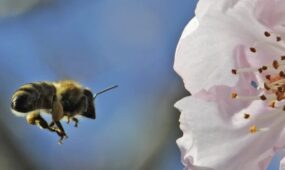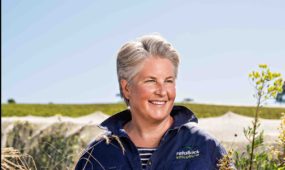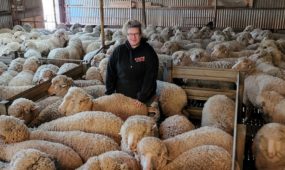Seafood capital rides high on tuna's back
Primary Industries
THE small South Australian fishing town of Port Lincoln has boat loads of evidence to support its claim as the seafood capital of Australia.

Sign up to receive notifications about new stories in this category.
Thank you for subscribing to story notifications.
While its reputation is based on a wide range of wild and cultured species, Southern Bluefin Tuna (Thunnus maccoyii) is undoubtedly the fish that has put this small Eyre Peninsula community on the map.
From booming catches to falling fish stocks and innovations in aquaculture that have revived the industry, Southern Bluefin Tuna (SBT) continues to mark the tide of Port Lincoln's fortunes.
This year, Australia's SBT industry, centred in South Australia, marks its 60th anniversary. While the fishery's first steps are recorded more than a decade earlier, 1956 is the year that fishing experts Chris and Sverre Jangaard from the United States made a successful expedition to Australia to share their fishing techniques and provide an assessment of the fishery's potential.
Port Lincoln historian Ross Haldane is well positioned to tell the story of the SBT industry as he is the son of Bill Haldane, one of the three brothers who pioneered tuna fishing in Australia. A former prawn fisher, Ross Haldane still owns a prawn boat and also holds some SBT quota. He was involved in fisheries management in South Australia for many years.
He says the potential of the SBT fishery was first recognised by CSIRO fisheries researcher Stanley Fowler in 1944 when he “hitched a ride” with a Royal Australian Air Force reconnaissance flight over the Great Australian Bight towards the end of World War II. This was when Stanley Fowler first identified abundant schools of migrating tuna off the South Australian coast. However, it was not until 12 years later that tuna fishing really kicked off on the Eyre Peninsula.
The development of the fishery from this point on, until the modern tuna ranching era, was shaped by a multitude of international influences, Ross Haldane says.
It began with the perseverance and ambition of the Haldanes, a Scottish boat-building and fishing family based in Victoria and later South Australia. Their vessel was modelled on the US tuna seiners and it was the expertise of the US-based Jangaard brothers, who were immigrants to the United StatesS from Norway, that finally kicked off the fishery in earnest.
In the 1950s and 1960s an influx of European immigrants, particularly from Croatia, led the expansion of the fishing effort in Port Lincoln, using the line and pole method the Jangaards had demonstrated during their visit in 1956.
Stepping back to view the international picture, Ross Haldane says that at the same time Australian efforts were beginning, the Japanese were also aggressively expanding their own fishing fleet, which had been restricted until 1952 by the US following World War II.
By the early 1960s, Australia was catching 8000 tonnes of SBT. The Japanese catch peaked in 1962 at 82,000 tonnes. There were three SBT fisheries operating in Australia at the time: Esperance, Western Australia; Port Lincoln; and off the coast of New South Wales. The Australian catch was canned for domestic consumption, while the Japanese sold most of their catch in Japan.
In the late 1970s the Australian fleet began to change from poling tuna to purse seine fishing. This technology was combined with Norwegian boat design, which proved better suited to the rougher waters in the Great Australian Bight than American boats, which generally fish in calm tropical waters.
New technology, already widely adopted by the US tuna fleet, included overhead power blocks to lift heavy catches and nylon nets that proved far more resistant to breaks and tears.
A combination of chumming boats and purse seine net boats allowed the fleet to improve its catch efficiency. By scattering handfuls of locally caught bait fish, chum boats would draw the fish to the surface while the net boats would encircle the school and unload them to larger chumming boats before casting their nets again.
However, by the mid 1980s the overall global SBT catch was beginning to decline. The Australian catch peaked at 21,000 tonnes in 1982, but the Japanese harvest of 40,000 tonnes was less than half its peak.
Japan introduced a ban on fishing in the spawning grounds, which lie in the Indian Ocean south of Indonesia, and moved its own fishing efforts further south into the Indian Ocean, the Southern Ocean and off the South African coast.
In 1983 an Australian Government inquiry found the SBT fishery was biologically over-exploited and heavily over-capitalised. Individual transferable quotas were introduced to the previously unregulated fishery.
Internationally, the Japanese and New Zealand governments also agreed to limit catches. Quotas were introduced, and then reduced, but between 1984 and 1988 fishers were unable to catch even the lower quotas. All three countries agreed to further reduce catch limits with annual reviews.
In 1989 a trilateral conference was held between Japan, Australia and New Zealand where it was agreed that the total combined yearly quota for all three countries would be limited to 11,750 tonnes. This informal management of the SBT fishery between the three countries was formalised in 1994 when the Commission for the Conservation of Southern Bluefin Tuna (CCSBT) was established.
Today, the extended commission has seven members: Australia, Japan, New Zealand, South Korea, Indonesia, Taiwan and the European Union. The Philippines and South Africa are co-operating non-members. The total allocation proposed for 2016-17 for these nine entities combined is 14,627 tonnes.
In 2011 the CCSBT adopted a harvest control rule called a management procedure (MP). The MP sets the quota based on the key data trends. Since it was adopted, the CCSBT quota has increased by 55 per cent and the Australian quota by 41 per cent based on the improvements in stock numbers.
The Australian domestic SBT fishery is managed by the Australian Fisheries Management Authority, which contributes data towards stock assessments conducted by the CCSBT scientific committee.
The 2014 SBT stock assessment suggested the spawning biomass was at nine per cent of its original biomass, and below the interim target of 20 per cent of original biomass target for a sustainable yield. However, there was improvement from the 2011 stock assessment, and the current catch quotas provide a 70 per cent probability of rebuilding to the 20 per cent target by 2035.
The FRDC has funded research to develop new and more accurate ways to assess SBT stocks, to more accurately monitor the rebuilding of the biomass. This includes a new genetics-based method of measuring the spawning stock, called the “close-kin” method, which has been used to analyse the 2006–10 SBT stock data. It indicates the actual spawning stock is up to three times the level indicated by the conventional stock assessment methods. This new approach is being extended to analyse data from more recent years, and the full period will be considered for use in the stock assessment and in a revised management plan.
Japan's expansion as far south as South Africa was aided by new technology, the development of freezing fish to minus 60°C, which effectively revolutionised the market for SBT. It allowed SBT, a highly fatty fish, to be frozen in prime condition. Super-cooled freezing stabilises fats in the flesh, which prevents degradation. And thus the SBT sashimi market was born, and what was once worth $2 per kilogram in cans became worth $45 per kilogram or more, as a premium culinary product. Ross Haldane says it was the Japanese interests that initially proposed ranching SBT, to grow out the smaller-sized fish migrating past Port Lincoln to a marketable size.
Towards the end of the 1980s the high-value sashimi market offered a glimmer of light for an industry that had struggled through the challenges of declining fish stocks, a 67 per cent quota cut, overcapitalisation, growing debts and a global recession.
Although Australia was not able to effectively tap into this market until the 1990s, the Japanese sashimi market is now the destination for 95 per cent of Australia's SBT. Ranching has revived the SBT industry in Port Lincoln and latest estimates put the value of the SBT industry at $122 million in 2013-14.
In 1991 the Tuna Boat Owners Association of Australia – now known as the Australian Southern Bluefin Tuna Industry Association (ASBTIA) – and the Federation of Japan Tuna Fisheries Co-operative Associations initiated a study to investigate the potential of growing out SBT captured at 15 to 20 kilograms. Northern Bluefin Tuna (Thunnus orientalis) were being ranched on a small scale in Japan, but from 400 grams, with more then 90 per cent mortalities. Other countries had also tried ranching other tuna species, but the fish were known to be easily spooked in closed environments, damaging themselves and the pontoons. SBT can swim at up to 70 kilometres an hour and grow to 200 kilograms.
The SBT study in Australia was conducted in conjunction with the Overseas Fishery Cooperation Foundation and with the support of the SA Government and the Australian Government. It was undertaken by the Australian SBT industry in partnership with the FRDC, and was one of the first projects funded by the FRDC after its formation in 1991. Brian Jeffriess, now the chief executive of the ASBTIA, was the lead investigator, and it was also one of the first projects for Patrick Hone, now executive director of the FRDC, as he was beginning his research career.
Hone says it was clear within two years that ranching SBT would be viable. The SBT proved more amenable to being ranched than some other species, and the young fish, generally two to four years old, could be quickly fattened to a size suited to the Japanese sashimi markets.
On the basis of this study, the industry began to capture SBT by poling individual fish into the wells of their vessels, and transporting them to pontoons in Boston Bay, SA. It was local fisher Dinko Lukin who introduced tow pontoons, which allowed the SBT to be purse seined in larger numbers. The innovation of towing pontoons greatly reduced fish mortality compared with previous capture and transfer methods.
The fish are towed from the point of capture, at speeds of about one knot, into the ranching pens, which can take two weeks. The pens were originally located in Boston Bay. However, a major storm in the Port Lincoln area in 1996 wiped out all the SBT stocks being ranched in the bay, and led the industry to relocate to much deeper water in the lower part of the Spencer Gulf.
Hone says since the initial project that established the potential for ranching, the FRDC has been partner in the development of the industry. As a co-funder of the Aquaculture Cooperative Research Centre (CRC), the Aquafin CRC and the Australian Seafood CRC, it has invested with industry in research involving fish health, nutrition, physiology and metabolism, product quality and the environment. Without the support from industry leaders such as Joe Puglisi, Sam Sarin, Tony Santic and Hagen Stehr, among others, to take this research and drive development, the industry would not be as it is today.
The collaboration of the FRDC and the CRCs with the SBT industry and major Australian research institutions has greatly enhanced and improved husbandry and production methods, and improved understanding of the international SBT fishery resource as a whole. For example, the FRDC funded a project that identified liver flukes as the cause of fish mortalities and development of treatment strategies.
Despite all that has been learnt, ASBTIA recognises there is still a long way to go to fully optimise ranching operations.
Since ranching began, the industry has steadily expanded to produce up to 9000 tonnes of gilled and gutted SBT annually with an estimated annual ex-farm value of about $200 million. Direct and indirect employment in Port Lincoln is estimated at the equivalent of more than 1000 full-time jobs. In 2016 there are eight companies ranching SBT with about 100 pontoons in specified aquaculture zones.
SBT ranching also resulted in the development of Australia's largest volume fishery, the Australian Sardine fishery in SA. This allowed the SBT industry to use locally caught feed for its operations, rather than importing feed from international fisheries – a practice that also presented a biosecurity risk. More than 90 per cent of the annual harvest from the SA sardine fishery is used to provide feed for SBT. The FRDC has also been involved in research to ensure the sardine fishery remains sustainable, including refining methods for estimating the biomass of this and other small pelagic species.
In December 2015 ASBTIA chief executive officer Brian Jeffriess announced that the Australian SBT fishery and farms had been awarded international sustainability certification by Friend of the Sea, a non-profit NGO that is the world's largest certifier of seafood. The Friend of the Sea sustainability award covers both the catching of Australian SBT from the wild and the value-added ranching of the catch. It includes the sustainability of the fishery, of the ecosystem (including any bycatch), of staff safety and labour conditions, the carbon footprint of organisations, product testing and traceability, animal husbandry and welfare, vessel monitoring and waste management.
The SA Government's support for the industry has helped to achieve the landmark certification. Continuous audits of industry operations and audit reports were important in the independent certification process.
Meanwhile, there is intense international competition to close the life cycle for SBT. This development requires a high cost of production, but would allow for complete control of SBT farming and remove pressure on wild resources that may be not sustainably managed.
In Australia, Hagen Stehr at Cleanseas had been driving research in this area, with research facilities at Arno Bay, near Port Lincoln, with assistance from the South Australian Research and Development Institute, the University of Tasmania and Japan's Kinki University. The Cleanseas research into breeding SBT is currently suspended.
This article originally appeared in Fisheries Research and Development Corporation’s magazine FISH
Jump to next article



